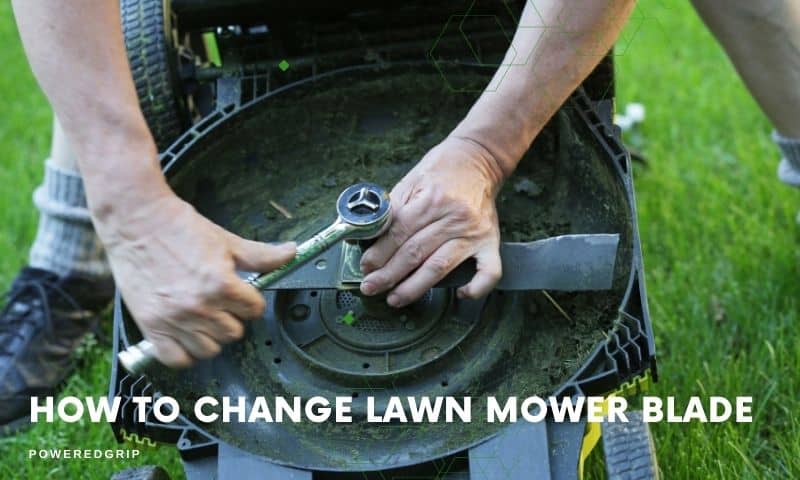How to Change Lawn Mower Blade: A Step By Step Guide

How to Change Lawn Mower Blade
Maintaining a healthy and attractive lawn requires regular lawn care and maintenance, and one of the key tools for this task is a lawn mower. However, a lawn mower’s blade can become dull or damaged over time, leading to poor cutting performance and even damage to the grass. In such cases, it is important to replace the lawn mower blade to ensure efficient and safe lawn mowing.
In this article, we will provide you with a step-by-step guide on how to change a lawn mower blade. We will cover everything from preparing for the task to testing the mower after blade replacement. By following our guide, you can ensure your lawn mower operates smoothly and keep your lawn looking its best. So let’s dive in!
Preparing for the Task
Choosing the Right Replacement Blade
Before starting the task of changing your lawn mower blade, it is important to choose the right replacement blade. The size, shape, and type of blade needed will depend on your specific lawn mower model. Consult your lawn mower’s user manual or manufacturer’s website to find the correct replacement blade.
It is also important to consider the type of grass you will be mowing. For instance, if you have thick, dense grass, you may need a blade with more cutting power. Conversely, if you have thin or delicate grass, a blade with fewer cutting edges may be more appropriate.
Gathering Necessary Tools and Equipment
To change your lawn mower blade, you will need the following tools and equipment:
- A wrench or socket set to remove the blade nut or bolt
- A blade removal tool or block of wood to secure the blade in place
- A new lawn mower blade
- A clean cloth or rag
Optional: a blade sharpener or professional sharpening service
Make sure you have all the necessary tools and equipment on hand before starting the task to avoid any delays or interruptions.
Safety Precautions to Take Before Starting the Task
Changing a lawn mower blade can be dangerous if not done properly, so it is important to take appropriate safety precautions before starting the task. Here are a few things to keep in mind:
- Turn off the lawn mower and disconnect the spark plug before working on the blade.
- Wear work gloves and eye protection to prevent injuries.
- Never work on the blade while the lawn mower is still running or while the blade is still spinning.
- Make sure the lawn mower is on a level surface and cannot move or tip over during the task.
By taking these safety precautions, you can reduce the risk of injury and complete the task with confidence.
Removing the Old Blade:
Positioning the Lawn Mower for Blade Removal
To remove the old blade, you need to position the lawn mower correctly. First, disconnect the spark plug wire to ensure the mower doesn’t accidentally start. Then, tip the mower on its side so you can access the blade. Make sure to prop the mower up securely so that it won’t fall over while you’re working on it. Consult your lawn mower’s user manual for specific instructions on how to properly position your mower for blade removal.
Securing the Blade in Place
Once you have positioned the lawn mower correctly, you need to secure the blade in place to prevent it from moving during removal. You can use a blade removal tool or a block of wood to secure the blade. A blade removal tool is designed to hold the blade in place, while a block of wood can be wedged between the blade and the deck to keep it from turning.
Removing the Blade Nut or Bolt
Next, you need to remove the blade nut or bolt that holds the blade in place. Use a wrench or socket set to loosen the nut or bolt, but do not fully remove it just yet. If the nut or bolt is difficult to remove, you can try using a penetrating oil to help loosen it.
Removing the Old Blade
Once the nut or bolt is loosened, you can remove the old blade from the lawn mower. Hold the blade firmly with one hand and use your other hand to remove the nut or bolt. Lift the old blade off of the mower and set it aside. Be careful when handling the blade as it may be sharp or heavy.
Remember to always wear gloves and eye protection when handling the blade and be sure to dispose of the old blade properly.
Installing the New Blade:
Checking the New Blade for Damage or Defects
Before installing the new blade, inspect it carefully to ensure it is free from damage or defects. Look for any cracks, bends, or other signs of wear that could compromise the blade’s performance or safety. If you notice any issues with the new blade, do not use it and contact the manufacturer for a replacement.
Positioning the New Blade Correctly
To position the new blade correctly, ensure that it is facing the right direction. The blade should have a label or arrow indicating which side should be facing down towards the grass. Align the center hole of the blade with the spindle shaft on the lawn mower deck.
Securing the Blade in Place
Once the new blade is in position, use a blade removal tool or block of wood to secure it in place. Make sure the blade is sitting flat against the spindle shaft and is not crooked or uneven. Use your hand to tighten the nut or bolt as much as you can before using a wrench or socket set to fully tighten it.
Tightening the Blade Nut or Bolt
When tightening the blade nut or bolt, use the appropriate tool and follow the manufacturer’s recommended torque specifications. Overtightening the nut or bolt can damage the blade or the lawn mower, while under-tightening can cause the blade to become loose during use. Always refer to your lawn mower’s user manual for specific instructions on how to tighten the blade nut or bolt.
Once the nut or bolt is securely tightened, remove the blade removal tool or block of wood and reattach the spark plug wire. Turn on the lawn mower and test the blade to make sure it is spinning properly and cutting efficiently.
Following these steps, you can install the new lawn mower blade correctly and ensure your lawn mower operates safely and efficiently.
Testing the Mower:
Starting the Mower
After installing the new blade, the next step is to start the lawn mower. Reattach the spark plug wire and follow the manufacturer’s instructions for starting the engine. Allow the engine to warm up for a few minutes before proceeding to the next step.
Checking the Blade for Proper Installation
Once the lawn mower is running, check the blade for proper installation. Look for any wobbling, vibrations, or unusual noises coming from the blade. A properly installed blade should be balanced and spin smoothly without any visible signs of damage or defects. If you notice any issues with the blade, turn off the lawn mower and double-check your installation.
Testing the Mower on a Small Patch of Grass
After confirming that the blade is installed correctly, test the lawn mower on a small patch of grass. Walk behind the mower and listen for any unusual noises or vibrations. Check the grass after mowing to ensure it is being cut evenly and efficiently. If you notice any issues with the lawn mower’s performance, turn off the engine and recheck the blade installation.
If the lawn mower is cutting properly and operating smoothly, you can continue using it as usual. However, it’s important to perform regular maintenance on your lawn mower, including sharpening the blade and changing it as needed, to ensure optimal performance and longevity.
Maintenance Tips:
Cleaning the Blade After Use
After using your lawn mower, it’s important to clean the blade to prevent rust and corrosion from building up. Use a brush or scraper to remove any grass clippings or debris from the blade. You can also use a damp cloth to wipe down the blade and remove any dirt or grime. Once the blade is clean, dry it off thoroughly and store it in a dry place.
Sharpening the Blade Periodically
Over time, lawn mower blades can become dull and ineffective at cutting grass. It’s important to sharpen the blade periodically to ensure optimal performance. You can use a blade sharpening tool or take the blade to a professional sharpening service. Always wear protective gloves when handling the blade and follow the manufacturer’s instructions for sharpening.
Replacing the Blade Regularly
Lawn mower blades are subject to wear and tear over time and may need to be replaced periodically. It’s important to check the blade regularly for signs of damage or wear and replace it as needed. A dull or damaged blade can cause the lawn mower to work harder, leading to increased fuel consumption and decreased efficiency. Always follow the manufacturer’s recommendations for replacing the blade and use only compatible replacement blades.
By following these maintenance tips, you can ensure that your lawn mower blade stays in good condition and operates safely and efficiently. Regular maintenance can also help prolong the life of your lawn mower and save you money in the long run.
Conclusion
Changing a lawn mower blade is a relatively simple task that can be completed in just a few steps. However, it’s important to take the necessary safety precautions and prepare for the task before beginning. By choosing the right replacement blade, gathering the necessary tools, and following the proper steps for removal and installation, you can change your lawn mower blade with ease.
It’s also important to remember to test the lawn mower after installing the new blade and perform regular maintenance, including cleaning, sharpening, and replacing the blade as needed. By following these tips, you can ensure that your lawn mower operates safely and efficiently, leading to a healthy and attractive lawn.
FAQs:
How often should I change my lawn mower blade?
Answer: Lawnmower blades should be checked regularly for signs of wear and tear, and replaced as needed. A good rule of thumb is to replace the blade once a year or after every 25 hours of use.
Can I sharpen my lawn mower blade instead of replacing it?
Answer: Yes, lawn mower blades can be sharpened to improve their performance and extend their lifespan. However, if the blade is severely damaged or worn, it may need to be replaced instead of sharpened.
What safety precautions should I take when changing my lawn mower blade?
Answer: Always wear protective gloves and eye goggles when handling the lawn mower blade. Disconnect the spark plug wire to prevent the engine from accidentally starting. Ensure that the lawn mower is positioned on a flat surface and that the blade is secured in place before removing it.

Kazi Taslim
Editor
Poweredgrip ensures that an expert team of writers provides you with excellent, unbiased informational content. We are dedicated to giving you the most up-to-date and smoothest information possible. We share incomparable tips and tricks that give you awareness and confidence when making your buying decisions. Our team is enthusiastic, dedicated, and hardworking. Kazi Taslim is the editor and head of our experienced writing team.
